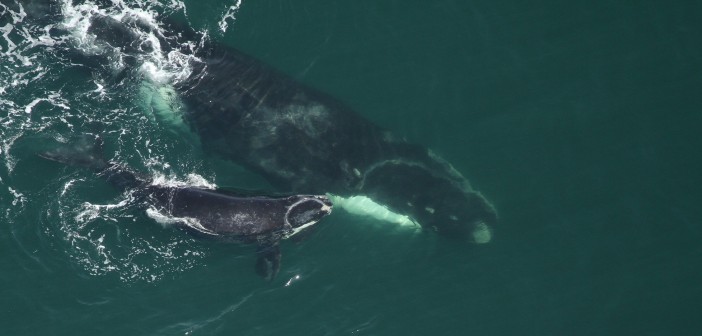(Right whale mother and calf. Photo credit: FWC Fish and Wildlife Research Institute, used under CC BY-NC-ND 2.0)
DURHAM, N.C. – Allowing underwater seismic surveys for oil and gas to be conducted off the U.S. Mid-Atlantic and Southeast coasts could pose a substantial threat to one of the world’s most critically endangered whale species, a group of leading marine scientists say.
In an open letter sent today to President Obama, the 27 scientists – including three from Duke University – cite evidence indicating that the North Atlantic right whale, whose population was most recently estimated at less than 500 animals, may now be declining in numbers.
Right whales communicate and navigate primarily by sound. They give birth and nurse their young from December through March each year in the relatively warm waters off the southeastern U.S. coast, primarily Georgia and Florida.
Exposing the whales to high-decibel industrial underwater airgun surveys in coastal waters between Delaware and Florida could represent a “tipping point” for the dwindling species, the scientists write, and “substantially increase the risk that the population will slip further into decline and jeopardize its survival.”
“The North Atlantic right whale relies heavily on a fundamental behavior: the ability of whales to communicate with one another using sound,” said Doug Nowacek, Repass-Rodgers Chair of Marine Conservation Technology at Duke. “The noise generated by seismic airguns, particularly along the urbanized U.S. East Coast, could jeopardize critical communications, such as vocally mediated mother-calf contact.”
The scientists urge the Obama Administration to defer issuing any permits for airgun surveys in the regions’ waters until after NOAA’s next status report on the health and size of the North Atlantic right whale population is released in 2017.
Scientists at the Cornell Lab of Ornithology, the New England Aquarium, Woods Hole Oceanographic Institution, the Wildlife Conservation Society and other research universities and environmental NGOs also signed the letter.
Last month, the Obama Administration announced it would delay issuing oil and gas leases in Mid-Atlantic and Southeast waters for the next five years, but seismic surveys – which are used by industry to locate underwater fossil fuel deposits for future extraction – may continue. Companies have already applied to survey as much as 90,000 miles of ocean floor off the East Coast.
Seismic survey impulses are among the loudest noises humans put into the oceans, and in some cases can be detected more than 2,500 miles away. At 260 decibels, the noise generated by the air guns roughly approximates the noise at the epicenter of a grenade blast and would easily cause the rupture of the human eardrum. Noise created by the surveys can mask sounds right whales and other species rely on to communicate, navigate, find food or avoid predators. Long-term exposure to the noise can also lead to chronic stress and disorientation in animals, and auditory damage.
“All of this is undetectable to someone at the surface, but the underwater impact and disturbance from these activities can be devastating to ocean life, especially for species such as the North Atlantic right whale,” said Christopher Clark, senior scientist at the Cornell Lab of Ornithology Bioacoustics Research Program.
The surveys will “disproportionally affect the most vulnerable members of the population: mothers and calves,” said Scott Kraus, vice president of research at the New England Aquarium.
Most surveys discharge their airguns approximately every 9 to 11 seconds and may continue, almost nonstop, for weeks or months on end. In some cases, animals could be subjected to concurrent pulses from overlapping surveys.
The impact of chronic exposure to these sounds often exceeds the projected short-term impacts regulatory agencies currently use to set acceptable sound-exposure levels, Nowacek said. Any meaningful environmental assessment of airgun surveys in the Atlantic must evaluate the cumulative impacts on the whales’ health and reproductive rates over time, he said.
In addition to Nowacek, other Duke scientists who signed the letter are Andrew J. Read, Stephen Toth Professor of Marine Biology, and Caroline Good, adjunct research professor. All three are on the faculty at Duke’s Nicholas School of the Environment. Nowacek also holds a joint appointment at the Pratt School of Engineering.
The North Atlantic right whale is designated as critically endangered on the International Union for the Conservation of Nature’s Red List and is protected in U.S. waters by the Endangered Species Act and the Marine Mammal Protection Act.
It was nearly hunted to extinction by commercial whaling. Today, its greatest threats include accidental collisions with large ships, entanglements with commercial fishing gear and ropes, and, increasingly, the disruption of its essential behaviors by noise pollution.
“Even with the proposal for oil and gas drilling off the table, seismic surveys are still of great concern and could jeopardize the long-term survival of this whale species,” said Howard Rosenbaum, director of the Wildlife Conservation Society’s Ocean Giants Program.





